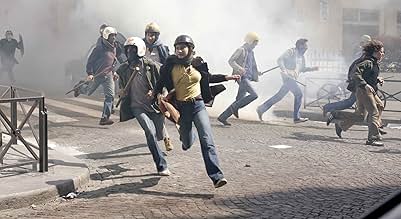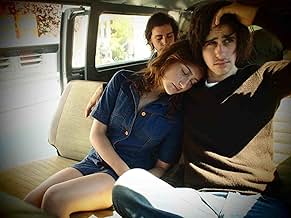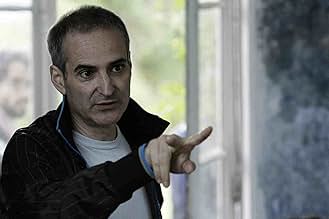Après mai
- 2012
- Tous publics
- 2h 2min
NOTE IMDb
6,4/10
4,8 k
MA NOTE
Dans les mois qui suivent les semaines enivrantes de Mai 68, un groupe de jeunes européens cherche un moyen de poursuivre la révolution qu'ils supposent à peine commencée.Dans les mois qui suivent les semaines enivrantes de Mai 68, un groupe de jeunes européens cherche un moyen de poursuivre la révolution qu'ils supposent à peine commencée.Dans les mois qui suivent les semaines enivrantes de Mai 68, un groupe de jeunes européens cherche un moyen de poursuivre la révolution qu'ils supposent à peine commencée.
- Réalisation
- Scénario
- Casting principal
- Récompenses
- 5 victoires et 4 nominations au total
Felix Armand
- Alain
- (as Félix Armand)
Bobbi Salvör Menuez
- Leslie
- (as India Salvor Menuez)
Avis à la une
In 1968 in Paris, France, the something in the air was revolution. In March of that year, a single spark began a revolt when a small group of students at Nanterre University took to the streets to protest conditions at the University. By July, workers had shut down Paris with a general strike in which ten million workers took part, occupying factories and marching in solidarity with students, who occupied the Sorbonne. The objectives were self-management by workers, a decentralization of economic and political power and participatory democracy in the factories and universities. By the end of July, the government of the autocratic Charles de Gaulle was teetering on the brink of collapse.
The impact of the 1968 near revolution is still being felt three years later in February, 1971 when Olivier Assayas' semi-autobiographical Something in the Air opens. A demonstration is held at the Place de Clichy in Paris as a teacher in a high school class reads a passage from Pascal, "Between us and Heaven or Hell there is only life, which is the frailest thing in the world." At the same time, the brutal police repression of a young protester, Richard Deshayes, takes place in nearby streets demonstrating the immediacy of Pascal's words. Deshaves loses an eye after being hit in the face by a smoke grenade, and the poster of his bloody head is shown as a symbol of resistance throughout the film.
Something in the Air is about coming-of-age and the awakening of conscience, and Assayas has the courage to remind us of the need to align our actions in life with our beliefs and conscience. Events are shown from the perspective of Gilles (Clément Métayer), a 17-year-old high school student who is a prospective filmmaker, painter of considerable talent as well as a political activist. Gilles and his friends Alain (Felix Armand) and Jean-Pierre (Hugo Conzelmann) are activists in the political arena, working to create a better society. They distribute leaflets, contribute articles to left-wing magazines, and spray paint graffiti slogans on the walls. After a security guard is seriously injured by a Molotov cocktail thrown by one of the protesters, however, Gilles and his new girlfriend Christine (Lola Creton) leave the country for Italy.
On the trip with a group of activist filmmakers, Gilles is told that he can only borrow a camera only if he does agitprop because "we don't do fiction." At a showing of a revolutionary film, a discussion follows about whether to use conventional style or "revolutionary syntax" to get their message across. Although the film is about ideas, we never know exactly which of the student activists are Anarchists, Trotskyites, Maoists, Marxists, Stalinists, or democratic Socialists, but it hardly seems to matter. What makes the film so unique is not only a script that is highly literate but its portrayal of young people with respect for their minds and an appreciation of their dignity and commitment, attributes normally not seen in films about the counterculture. Author Anne Morris said, "The irony of commitment is that it's deeply liberating – in work, in play, in love."
Assayas correctly notes that, in addition to advocating political and economic change, the protesters also want to change outmoded social conventions, particularly the stranglehold of the scientific/materialist paradigm and the puritan sexual mores that place barriers on spiritual growth and full self-expression. What comes across as special, even more than ideas about filmmaking or political theory, are the relationships they have with each other that express their openness and love. The film also blends idealism with music in a way that the songs of Syd Barrett-era, Booker T & the MG's, Nick Drake, and an inspiring rendition of a Phil Ochs song by Johnny Flynn feel organic to the scenes in which they are used.
When the students ultimately gain a sense that life is governed by practicality as well as idealism, they gradually drift away to parents, jobs, school and the careers that will shape their lives, but they have already made a difference. Though their immediate objectives were only partially met, later in the year, uprisings began in Poland and Czechoslovakia that would have a profound effect on the Soviet system, protesters marched at the Democratic Convention in Chicago, rioted at Kent State, and the brutal war against a small, peasant country came to an end several years later.
Though the film is more about personal goals and ambitions than revolution and Assayas does not shed much light on the causes that the students fought for, no film in recent memory has presented such an authentic view of the immediacy of the period as Something in the Air. The feeling of change is electric and its mood is brilliantly reflected by the film's lack of cynicism and condescension. Assayas brings us back to a time when everything seemed possible and people were truly young because the world, maybe for the first time, began to dream of what it would be like to be young with them.
The impact of the 1968 near revolution is still being felt three years later in February, 1971 when Olivier Assayas' semi-autobiographical Something in the Air opens. A demonstration is held at the Place de Clichy in Paris as a teacher in a high school class reads a passage from Pascal, "Between us and Heaven or Hell there is only life, which is the frailest thing in the world." At the same time, the brutal police repression of a young protester, Richard Deshayes, takes place in nearby streets demonstrating the immediacy of Pascal's words. Deshaves loses an eye after being hit in the face by a smoke grenade, and the poster of his bloody head is shown as a symbol of resistance throughout the film.
Something in the Air is about coming-of-age and the awakening of conscience, and Assayas has the courage to remind us of the need to align our actions in life with our beliefs and conscience. Events are shown from the perspective of Gilles (Clément Métayer), a 17-year-old high school student who is a prospective filmmaker, painter of considerable talent as well as a political activist. Gilles and his friends Alain (Felix Armand) and Jean-Pierre (Hugo Conzelmann) are activists in the political arena, working to create a better society. They distribute leaflets, contribute articles to left-wing magazines, and spray paint graffiti slogans on the walls. After a security guard is seriously injured by a Molotov cocktail thrown by one of the protesters, however, Gilles and his new girlfriend Christine (Lola Creton) leave the country for Italy.
On the trip with a group of activist filmmakers, Gilles is told that he can only borrow a camera only if he does agitprop because "we don't do fiction." At a showing of a revolutionary film, a discussion follows about whether to use conventional style or "revolutionary syntax" to get their message across. Although the film is about ideas, we never know exactly which of the student activists are Anarchists, Trotskyites, Maoists, Marxists, Stalinists, or democratic Socialists, but it hardly seems to matter. What makes the film so unique is not only a script that is highly literate but its portrayal of young people with respect for their minds and an appreciation of their dignity and commitment, attributes normally not seen in films about the counterculture. Author Anne Morris said, "The irony of commitment is that it's deeply liberating – in work, in play, in love."
Assayas correctly notes that, in addition to advocating political and economic change, the protesters also want to change outmoded social conventions, particularly the stranglehold of the scientific/materialist paradigm and the puritan sexual mores that place barriers on spiritual growth and full self-expression. What comes across as special, even more than ideas about filmmaking or political theory, are the relationships they have with each other that express their openness and love. The film also blends idealism with music in a way that the songs of Syd Barrett-era, Booker T & the MG's, Nick Drake, and an inspiring rendition of a Phil Ochs song by Johnny Flynn feel organic to the scenes in which they are used.
When the students ultimately gain a sense that life is governed by practicality as well as idealism, they gradually drift away to parents, jobs, school and the careers that will shape their lives, but they have already made a difference. Though their immediate objectives were only partially met, later in the year, uprisings began in Poland and Czechoslovakia that would have a profound effect on the Soviet system, protesters marched at the Democratic Convention in Chicago, rioted at Kent State, and the brutal war against a small, peasant country came to an end several years later.
Though the film is more about personal goals and ambitions than revolution and Assayas does not shed much light on the causes that the students fought for, no film in recent memory has presented such an authentic view of the immediacy of the period as Something in the Air. The feeling of change is electric and its mood is brilliantly reflected by the film's lack of cynicism and condescension. Assayas brings us back to a time when everything seemed possible and people were truly young because the world, maybe for the first time, began to dream of what it would be like to be young with them.
There's revolution on the mind in Something in the Air, as we watch a group of young idealists rage against the injustices in the world whilst also trying to figure out their own lives. Set in the early 1970s, this film looks and sounds the part, with a beautiful washed-out colour palette matched by a cracking soundtrack.
The storyline of Something in the Air feels a little uneven as it lurches between revolutionary activities and the human drama of the characters, however there's an underlying warmth to this film that makes it an enjoyable watch. The characters feel real, to the extent that this feels like just a snapshot of their lives, and that they lived before and after the small period we spend with them.
This isn't a flawless film. I would've liked to have spent a bit more time with some of the characters, getting to know their motivations deeper. However, provided you don't find the politics off-putting it's a pleasant way to spend a couple of hours.
The storyline of Something in the Air feels a little uneven as it lurches between revolutionary activities and the human drama of the characters, however there's an underlying warmth to this film that makes it an enjoyable watch. The characters feel real, to the extent that this feels like just a snapshot of their lives, and that they lived before and after the small period we spend with them.
This isn't a flawless film. I would've liked to have spent a bit more time with some of the characters, getting to know their motivations deeper. However, provided you don't find the politics off-putting it's a pleasant way to spend a couple of hours.
Gilles is an interesting character, a political activist studying to be an artist. But it's frustrating that beyond his political beliefs we get to know little about him. Conversations are short. What do any of the people feel? There are a lot of opinions and judgments made about society, authority, each other - usual for French films. But left me unsatisfied. Warning: Ironically, be prepared to meet many dissatisfied people, even majorly unhappy ones, during the course of this film. Wonderful evocation of times ('70s) and attention to detail though.
Olivier Assayas's film 'Something in the Air' is an affectionate, although not uncritical, look at the lives of young French radicals after 1968. Watching it, you get an interesting sense of an era when students were interested in something other than building their careers (although the protagonists don't all completely abandon their bourgeois dreams); there's also the contrast between their profound political beliefs, and the feeling that their beloved freedom is basically the freedom of being young and moneyed - the revolution as a gap year, so to speak. The way that a life spent chasing experience ultimately does not build the foundation of lasting relationships is also well-conveyed. Overall, the cast are a little too beautiful - who wouldn't be a revolutionary when the benefits were so obvious? - and if the film has a serious weak-point, it's in not fully explaining quite why youth was drawn to the counter-culture except in a vague, spirit-of-the-age type way. A final quibble - the English translation of the French title (Apres Mai) is an awful one, better befitting a light romantic comedy.
It's a fascinating period, late 60s France from the perspective of the student movement.
The violence of the police, the underground press, the graffiti, protests, the connection and disagreements with the other socialist groups, the independent cinema collectives.
With the backdrop of the music and art of that era.
What this film is really about though is wanting to support a cause but also trying to decide upon your own future. I think they pull this off well by following the characters individually rather than just when they are a group.
It's beautifully shot and in some very picturesque locations.
I think it is a very good film.
The violence of the police, the underground press, the graffiti, protests, the connection and disagreements with the other socialist groups, the independent cinema collectives.
With the backdrop of the music and art of that era.
What this film is really about though is wanting to support a cause but also trying to decide upon your own future. I think they pull this off well by following the characters individually rather than just when they are a group.
It's beautifully shot and in some very picturesque locations.
I think it is a very good film.
Le saviez-vous
- AnecdotesWith the exception of Lola Créton, the actors portraying the youths were inexperienced, mostly first-time actors found through director Olivier Assayas and casting director Antoinette Boulat having flyers handed out in front of high schools and having set up a casting Facebook page. They did audition other experienced young actors, but only Créton was selected.
- ConnexionsFeatured in At the Movies: Venice Film Festival 2012 (2012)
Meilleurs choix
Connectez-vous pour évaluer et suivre la liste de favoris afin de recevoir des recommandations personnalisées
- How long is Something in the Air?Alimenté par Alexa
Détails
- Date de sortie
- Pays d’origine
- Sites officiels
- Langues
- Aussi connu sous le nom de
- Something in the Air
- Lieux de tournage
- Brunoy, Essonne, France(High School: Lycee Talma)
- Sociétés de production
- Voir plus de crédits d'entreprise sur IMDbPro
Box-office
- Budget
- 5 400 000 € (estimé)
- Montant brut aux États-Unis et au Canada
- 85 154 $US
- Week-end de sortie aux États-Unis et au Canada
- 13 288 $US
- 5 mai 2013
- Montant brut mondial
- 1 305 473 $US
- Durée
- 2h 2min(122 min)
- Couleur
- Mixage
- Rapport de forme
- 1.85 : 1
Contribuer à cette page
Suggérer une modification ou ajouter du contenu manquant


























